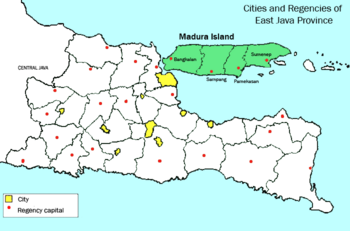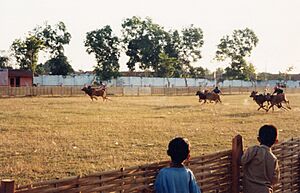Madura Island facts for kids

Topography of Madura (above)
Location of Madura in East Java (below) |
|
 |
|
| Geography | |
| Location | Southeast Asia |
| Coordinates | 07°03′36″S 113°24′00″E / 7.06000°S 113.40000°E |
| Archipelago | Greater Sunda Islands |
| Total islands | 127 |
| Major islands | Madura, Kangean |
| Area | 5,374.17 km2 (2,074.98 sq mi) |
| Highest elevation | 500 m (1,600 ft) |
| Highest point | Lanjari Hill |
| Administration | |
|
Indonesia
|
|
| Province | East Java |
| Largest settlement | Pamekasan |
| Demographics | |
| Population | 4,060,713 (mid 2023 estimate) |
| Pop. density | 755.6 /km2 (1,957 /sq mi) |
| Ethnic groups | Madurese |
| Additional information | |
| Time zone | |
Madura Island is an Indonesian island located off the northeast coast of Java. It's separated from Java by the narrow Madura Strait. The island is part of the East Java province. Madura is home to about 4 million people. It is known as "The Salt Island" because it produces a lot of salt.
Contents
What's in a Name?
Madura Island gets its name from Madurai. This is a place in India that is important in the Hindu religion. It is linked to the Hindu god Azhagar.
A Quick Look at Madura's Past
In 1624, Sultan Agung from the Mataram Kingdom took control of Madura. The island was then ruled by the Cakraningrat family. This family often disagreed with the rulers in Central Java.
Later, in 1705, the Dutch gained power over the eastern part of Madura. This happened after a war in Java. The Cakraningrat family tried to work with the Dutch. However, in 1743, the Dutch took full control of Madura.
The Dutch kept Madura divided into four areas. Each area had its own local leader. Madura became very important for providing soldiers. In the late 1800s, it also became the main source of salt for the Dutch. The Dutch slowly took direct control of the whole island. From 1948 to 1950, Madura was a separate state within Indonesia.
Madura's Landscape
Madura Island has a mostly flat landscape. There are no big mountains or huge changes in height. Geologically, it's part of the northern limestone hills of Java. The limestone hills on Madura are generally lower and more rounded.
People and Languages of Madura
Madura Island, including its smaller islands nearby, has about four million people. Most of these people are Madurese. The main language spoken here is Madurese. This language is also spoken in parts of eastern Java and on many surrounding islands.
The Madurese people are a large group in Indonesia, with about 7 million people in total. Many Madurese also live in the eastern part of East Java. Madura is home to people of different faiths, mainly Sunni and Shia Muslims. It's important for everyone to live together peacefully.
How Madura is Divided
Madura Island is part of the East Java province. It is split into four main areas called regencies. These are listed from west to east:
| Name | Capital | Area (km2) |
Population 2000 census |
Population 2010 census |
Population 2020 census |
Population mid 2023 estimate |
|---|---|---|---|---|---|---|
| Bangkalan Regency | Bangkalan | 1,260.15 | 805,048 | 906,761 | 1,060,377 | 1,047,306 |
| Sampang Regency | Sampang | 1,228.25 | 750,046 | 877,772 | 969,694 | 988,360 |
| Pamekasan Regency | Pamekasan | 792.30 | 689,225 | 795,918 | 850,057 | 882,837 |
| Sumenep Regency | Sumenep | 2,093.47 | 985,981 | 1,042,312 | 1,124,436 | 1,142,210 |
| Totals | 5,374.17 | 3,230,300 | 3,622,763 | 4,004,564 | 4,060,713 |
The Sumenep Regency includes not only the eastern part of Madura Island but also many islands nearby. These include the Kangean Islands and the Sapudi Islands.
Madura's Economy
Madura is one of the poorer areas in East Java. The soil isn't very fertile, so it's not a big farming region for food. Because of limited jobs, many Madurese people have moved to other parts of Indonesia. This was often part of government programs to help people move.
Farming is still very important for people to live. Maize (corn) is a key crop grown on small farms. Raising Cattle is also a big part of the economy. It gives families extra money and is used for Madura's famous bull-racing events. Small-scale fishing also helps people earn a living.
For products that are sold, tobacco farming is very important. Madura's soil is good for growing tobacco and cloves. These are used to make kretek (clove cigarettes) in Indonesia. Since the time of the Dutch, Madura has also been a major producer and exporter of salt.
The western part of the island, Bangkalan, has grown a lot with industries since the 1980s. It's close to Surabaya, Indonesia's second-largest city. This makes Bangkalan a good place for people who work in Surabaya to live. It's also good for businesses that need to be near the city. The Suramadu Bridge, which opened in 2009, has made it even easier to travel between Madura and Surabaya.
Madura's Climate
Most of Madura is low and close to the equator. This means the island is warmer and drier than mainland East Java.
| Climate data for Pamekasan, East Java, Indonesia (elevation 15 meters or 49 feet) | |||||||||||||
|---|---|---|---|---|---|---|---|---|---|---|---|---|---|
| Month | Jan | Feb | Mar | Apr | May | Jun | Jul | Aug | Sep | Oct | Nov | Dec | Year |
| Mean daily maximum °C (°F) | 31 (88) |
30.8 (87.4) |
31 (88) |
31.5 (88.7) |
31.7 (89.1) |
31.4 (88.5) |
31.1 (88.0) |
31.6 (88.9) |
32.3 (90.1) |
33 (91) |
33 (91) |
31.6 (88.9) |
31.7 (89.0) |
| Daily mean °C (°F) | 26.7 (80.1) |
26.5 (79.7) |
26.6 (79.9) |
27 (81) |
27.1 (80.8) |
26.5 (79.7) |
26 (79) |
26.3 (79.3) |
26.9 (80.4) |
27.7 (81.9) |
28 (82) |
27 (81) |
26.9 (80.4) |
| Mean daily minimum °C (°F) | 22.4 (72.3) |
22.3 (72.1) |
22.3 (72.1) |
22.6 (72.7) |
22.5 (72.5) |
21.7 (71.1) |
21 (70) |
21.1 (70.0) |
21.6 (70.9) |
22.5 (72.5) |
23 (73) |
22.5 (72.5) |
22.1 (71.8) |
| Average precipitation mm (inches) | 260 (10.2) |
239 (9.4) |
254 (10.0) |
179 (7.0) |
107 (4.2) |
72 (2.8) |
41 (1.6) |
11 (0.4) |
11 (0.4) |
38 (1.5) |
122 (4.8) |
239 (9.4) |
1,573 (61.7) |
| Average relative humidity (%) | 82.9 | 83.5 | 84.2 | 80.8 | 80.1 | 77.5 | 74.9 | 72.8 | 72.2 | 72.1 | 75.6 | 81.2 | 78.2 |
| Source 1: Climate-Data.org (temp & precip) | |||||||||||||
| Source 2: Weatherbase (humidity) | |||||||||||||
The climate along Madura's coast is a tropical savannah climate.
| Climate data for Payudan Nangger, Sumenep, East Java (elevation 337 meters or 1,106 feet) | |||||||||||||
|---|---|---|---|---|---|---|---|---|---|---|---|---|---|
| Month | Jan | Feb | Mar | Apr | May | Jun | Jul | Aug | Sep | Oct | Nov | Dec | Year |
| Mean daily maximum °C (°F) | 28.7 (83.7) |
28.7 (83.7) |
29 (84) |
29.7 (85.5) |
29.7 (85.5) |
29.4 (84.9) |
29 (84) |
29.5 (85.1) |
30.3 (86.5) |
31 (88) |
30.8 (87.4) |
29.4 (84.9) |
29.6 (85.3) |
| Daily mean °C (°F) | 24.5 (76.1) |
24.5 (76.1) |
24.8 (76.6) |
25.3 (77.5) |
25.2 (77.4) |
24.8 (76.6) |
24.3 (75.7) |
24.6 (76.3) |
25.2 (77.4) |
26 (79) |
— | 25 (77) |
— |
| Mean daily minimum °C (°F) | 20.4 (68.7) |
20.4 (68.7) |
20.6 (69.1) |
20.9 (69.6) |
20.8 (69.4) |
20.3 (68.5) |
19.7 (67.5) |
19.7 (67.5) |
20.2 (68.4) |
21 (70) |
21.2 (70.2) |
20.7 (69.3) |
20.5 (68.9) |
| Average precipitation mm (inches) | 331 (13.0) |
288 (11.3) |
294 (11.6) |
219 (8.6) |
116 (4.6) |
66 (2.6) |
39 (1.5) |
17 (0.7) |
11 (0.4) |
63 (2.5) |
172 (6.8) |
272 (10.7) |
1,888 (74.3) |
| Source: Climate-Data.org (temp & precip) | |||||||||||||
The climate in inland Madura is also a tropical savannah climate.
Madura's Culture
Exciting Bull Racing
Madura is very famous for its bull-racing competitions, called karapan sapi. In these races, a young boy rides a simple wooden sled. Two strong bulls pull the sled over a course of about 100 meters. It's a fast and exciting event!
Music and Theatre Fun
Many types of music and theatre are popular on Madura. They are a fun and affordable way for people to enjoy themselves and connect. The topeng theatre uses masks to tell classic stories like the Ramayana. This type of theatre is well-known outside Madura.
A less formal type of theatre is loddrok. Here, performers don't wear masks and tell a wider variety of stories. This is more popular on the island itself. The gamelan orchestra, a classical Javanese instrument, is also played on Madura. Tongtong music is unique to Madura. It's played on wooden or bamboo drums and often goes along with the bull-racing competitions.
Amazing Madurese Boats
The Madurese people are known for being excellent sailors. Their traditional boats, like the golekan and leti leti, used to carry wood and other goods. They would travel between Indonesia and Singapore. Other traditional boats include the lis-alis and janggolan.



